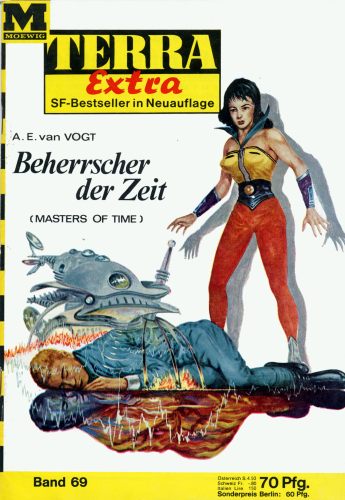Alfred Elton van Vogt : Beherrscher der Zeit (Masters of Time)
Terra Extra 69, 14.05.1965
Neuauflage
Deutsche Erstausgabe UTOPIA Großband 125, 1960
Amerikanische Originalausgabe FANTASY PRESS 1950
Aus dem Kanadischen von Heinz Bingenheimer
Titelbild : Johnny Bruck
Dr. Lell und seine Supermenschen sind die Beherrscher der Zeit. Sie stammen aus ferner Zukunft und durchstreifen alle Epochen der irdischen Vergangenheit. Ein gewaltiger, verlustreicher Krieg tobt in ihrer eigenen Zeit. Die Besucher aus der Zukunft haben die Mission, unter Vorspiegelung falscher Tatsachen Menschen zu rekrutieren, die für sie kämpfen sollen. Jack Garson ist einer dieser Rekruten. Er erkennt, was gespielt wird, und durchkreuzt Dr. Lells Pläne. Zusammen mit der Frau, die er liebt, beginnt er einen Privatkrieg gegen die Supermenschen. Jack Garson bleibt keine andere Wahl, denn es geht um das Schicksal der Menschheit.Klappentext
Norma was a helpless victim of the masters of time; Jack, who loved her, went willingly into slavery, hoping to find a way to release her from bondage. Both of them should have been destroyed, yet somehow, gaining strength from each other, they managed to retain some measure of their free will. But was it enough to save both of them - and, more important, to save Earth from the monstrous fate that the masters of time had decreed for it?Klappentext der amerikanischen Ausgabe
SF-Action-Trash. Ein Fix-Up zweier uralter Kurzgeschichten, "The Changeling" (Astounding, April 1944) und "Earth's Last Fortress" (Astounding, März 1942), bei dem van Vogt ein ziemliches Chaos angerichtet hat. Damon Knight beschreibt dies deutlich und pointiert :
The contrast is even plainer in THE MASTERS OF TIME. CHANGELING deals with van Vogt's favorite theme: the superman who doesn't know he's a superman. The plot is complex, involving two power groups, one of which is not identified until late in the story; the action expands wildly in all directions, and, as usual, is resolved abruptly in the last two pages by means of a rabbit previously contained in Mr. van Vogt's hat. RECRUITING STATION concerns two normal people caught up in the vast, cloudy machinations of two warring groups in the future; here again scenes shift abruptly, basic elements of the story are kept hidden till the end and then unsatisfactorily explained; and as an added attraction van Vogt has introduced a string of unresolved time paradoxes.The Dissecting Table, Januar 1951
Van Vogt's method, according to himelf, is to work in 800-word "blocks", EACH OF WHICH INTRODUCES A NEW IDEA. This packing technique is undeniably a major contribution to science-fantasy writing; in the hands of at least one other writer, Charles L. Harness, it produces scripts of unparalleled brilliance and impact. But in the innovator's own work the effect is simply that of a senseless bombardment, which might well be labeled "the Kitchen Sink Technique." The essential difference is that a Harness story, in spite of its internal complexity, has an over-all shape which is coherent and symmetrical; the typical van Vogt product is formless.
Dem ist nichts mehr hinzuzufügen.

Keine Kommentare:
Kommentar veröffentlichen